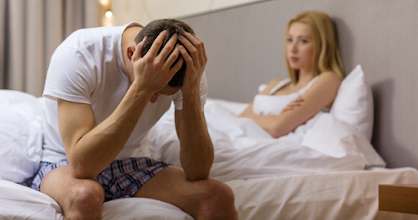Low Libido: What Causes Low Libido?
READ ALSO: 5 Commonly Used Medications That Could Be Killing Your S*x Drive
But most of the time when people bring it up to me, the first thing they want me to check are hormones. Which hormones might be responsible are of course different between men and women, though there is some overlap. I’ll discuss the role of the sex hormones first, since several of the other possible causes influence these.
Low Libido in Men
High Sex Hormone Binding Globulin (SHBG) goes hand-in-hand with this: low T raises SHBG, which compounds the problem, since SHBG binds most strongly to androgens, like testosterone. (It turns out that eating plenty of protein lowers SHBG, though–which also happens to be great for reversing Metabolic Syndrome, if it’s an issue.)
Low Libido in Women
It’s long been assumed that if testosterone is good for male libido, then it must be beneficial for female libido as well. But this study suggests that this is only true if supraphysiologic doses (higher than what the body naturally makes) are given in conjunction with estrogen—at which point women are at risk for testosterone overdose symptoms, such as irritability, abnormal hair growth, oily skin, and acne.In fact, for women, estrogen seems to be the biggest hormonal influence for libido, while testosterone is neutral and progesterone seems to be suppressive.
The fact that estrogen seems to be the biggest libido boost jives with many women’s report that they experience higher libido at certain times of their cycles, and especially just around ovulation, when estrogen is at its highest.
This may also explain why many women report lower libido on birth control, as they suppress ovulation (and therefore will blunt the estrogen spike around that time). It also helps to explain lower libido post-partum in breastfeeding moms, since the prolactin required to produce milk suppresses ovulation, which therefore suppresses estrogen. Prolactin also raises SHBG.
And of course, libido often drops off for women around perimenopause and menopause, when hormones—including estrogen—are in steep decline.
High levels of S*x Hormone Binding Globulin plays a role for women too, though less so than for men, for two reasons: 1) because the affinity of SHBG is lower for estrogen than it is for androgens, and 2) because low estrogen does not trigger a rise in SHBG the way low testosterone does.
READ MORE:15 FOODS THAT HELP MEN PERFORM BETTER
Neurotransmitters and Libido
Estrogen also decreases the functioning of the enzymes MAO and COMT, which break down the catecholamines (dopamine, norepinephrine and epinephrine)—and thus, adequate estrogen means you have more of these neurotransmitters to go around. Catecholamines, when in balance, are the neurotransmitters associated with joy and excitement. Also, dopamine in particular is the neurotransmitter associated with pleasure and reward, making it a key component of sexual function. The “opposite” of dopamine is serotonin. Perhaps not surprisingly, then, a common side effect of SSRIs (Selective Serotonin Reuptake Inhibitors) is low libido. This is not a side effect of Wellbutrin, though, as it is an NDRI which instead inhibits the reuptake of catecholamines.
SSRIs and other types of antidepressants also raise SHBG (by raising prolactin), as do anti-anxiety medications such as Xanax and Buspar. This, too, will lower libido for both sexes.
Stress and Libido
Stress almost universally lowers libido, for two reasons: 1) stress boosts cortisol, which means decreased production of DHEA, the precursor to both testosterone and estrogen. 2) Stress leads to fatigue, and fatigue leads to low libido for both sexes, as well, because you just don’t have the energy. In fact I’d say that fatigue is the most common cause for low libido I see in women especially.Along those lines…
Hypothyroidism and Libido
There is a huge connection between thyroid function and sex hormones, as it decreases both estrogen and testosterone levels. For this reason, most hypothyroid patients experience some sexual dysfunction. The good news is, this is correctable when thyroid levels are adequately treated.
The Upshot
There are many possible causes of low libido, not all of them hormonal—but even the hormonal possibilities are many and varied. Here’s a quick summary for testing purposes:
If you’re a man, ask your doctor to check free and total testosterone, SHBG, DHEA, a full thyroid panel, and various markers for Metabolic Syndrome including lipids, insulin, prolactin, glucose, and HbA1c. A salivary cortisol test for cortisol levels would be a good idea too!
Either gender might consider urinary neurotransmitter testing, if initial tests do not reveal the cause.
SOURCE:www.drlaurendeville.com













.jpeg)